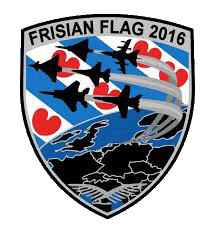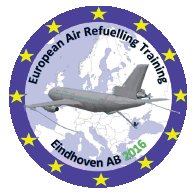|
Frisian flag 2016
Karo-Aviation visit Leeuwarden airbase for
Frisian flag 2016
Article and pictures by Ronald de Roij
Frisian Flag is an
annual multinational exercise.
This year, the pilots from America, Belgium, Britain, Finland, France,
Germany, Norway and of course, Holland participated in the exercise.
Around 70 aircraft from of a variety of types where involved in the
operation, including the British Tornados, French Mirage 2000 fighters,
Finish F-18 Hornet, German Euro fighters , American F-15 Eagles and F-16
Falcon from various countries..

|
With typically 50 jets participating in each of the
twice-daily missions, getting them all airborne from a
single runway took more than an hour. Air-air refuelling
aircraft were available to top up the fuel tanks to prolong
aircraft endurance.
|
Eight USAF F-15
Eagles participated in this year’s Frisian Flag, marking the second
involvement between the U.S. Air Force and Frisian Flag under the scope
of Operation Atlantic Resolve after the participation off the F-15 Eagle
last year. Participating in the largest fast jet exercise to be held in
Europe this year, joining units from other nations, giving the Eagle
drivers an opportunity to fly against aircraft and forces they normally
not encounter on a dally basis.
Frisian Flag
 Frisian
Flag traces its history from an exercise that was organized by the Dutch
air force as a national exercise using its Air defense and Ground Based
Air Defense units. These exercise where coordinated from Leeuwarden air
base by 232 squadron, after a mission the results were debriefed with
all participants. In 1992 this resulted in the exercise DIATIT, the name
is a combination of the Diana (the goodish of hunt) part of the squadron
emblem of 323 Squadron along with the abbreviation of coming from
Tactical Integrated Training. Frisian
Flag traces its history from an exercise that was organized by the Dutch
air force as a national exercise using its Air defense and Ground Based
Air Defense units. These exercise where coordinated from Leeuwarden air
base by 232 squadron, after a mission the results were debriefed with
all participants. In 1992 this resulted in the exercise DIATIT, the name
is a combination of the Diana (the goodish of hunt) part of the squadron
emblem of 323 Squadron along with the abbreviation of coming from
Tactical Integrated Training.
Integrated in this exercise is meaning that assets the Navy, Army and
Air Force are combined in this exercise as combined elements of the
training syllabus. As of 1993 until 1996 and AWACS was added to the
scenario, which resulted in exercise named DIAWACS, the exercises main
objective being the protection of the AWACS. The involvement of an AWACS
was postponed in 1997 and 1998 due to other commitments of the AWACS
aircraft. The exercise was renamed again to DIATIT for these two years.
After interest was shown from other NATO members, for participation in
this exercise. The set op of the exercise was changed to allow for
multinational participation and the name was changed again, this time in
to Frisian Flag. Making the exercise comparable to the Red Flag in the
United Sates and Maple Flag in Canada. With so many and diverse
participants, there is a lot of experience gathering at Leeuwarden
during the Frisian Flag exercises. Lessons learned from recent
operations, including those of NATO and PfP air forces over Libya and
Afghanistan, but also from other exercises held recently, are all taken
into account and integrated into the exercise scenarios.
Leeuwarden is ideally situated close to the vast training area over the
North Sea in Dutch and Overland training areas are nearby to provide
additional training value.

This
Mirage 2000D is marked with nine stars as a remembrance
for those who perished in the accident at Albacete during
the TLP on 26-01-2015 .
|
 The
main goal of the exercise is to get the aviators prepared to cooperate
during a variety of conflicts, and within a wide spectrum of threats
present in the operating environment. It is very important to speak a
single language during such operations. The
main goal of the exercise is to get the aviators prepared to cooperate
during a variety of conflicts, and within a wide spectrum of threats
present in the operating environment. It is very important to speak a
single language during such operations.
Remaining training goals include: planning the composite air operations
(COMAO) sorties in a realistic contemporary battlefield environment, in
line with the NATO standards; perfecting the tactical skills required
for COMAO sorties and debriefing; establishing cooperation between the
NATO member states; and carrying out relevant air-refueling training
With typically 50 jets participating in each of the twice-daily
missions, getting them all airborne from a single runway took more than
an hour. Air-air refueling aircraft were available to top up the fuel
tanks to prolong aircraft endurance.
All the fighter aircraft carried an instrumentation pod which provided
positional data of every aircraft which was replayed at a mass debrief
attended by all the pilots. The analysis of the tactics and targeting,
which can include displaying an individual pilot’s perspective, prompted
frank discussion on the various elements of the overall mission. The
data can show, for example, whether a simulated missile shot would have
hit its target.
131st Expeditionary Fighter Squadron
The US Air force has
sent a dozen F-15C fighter jets and some 350 airmen to Iceland and the
Netherlands, under the designation of the 131st Expeditionary Fighter
Squadron, along with airmen from Bases in Germany, will operate as a
Theater Security Package (TSP) to conduct training with NATO allies and
partners.
The 131st Expeditionary Fighter Squadron consists off units from the
131st Fighter Squadron at Barnes Air National Guard Base in
Massachusetts and the 194th Fighter Squadron at Fresno Air National
Guard Base in California.
The reason for the theatre security package is the increased Tensions
between Russia and the West in March 2014 after Ukraine’s Black Sea
peninsula of Crimea jointed the Russian Federation following a
referendum.
NATO eventually severed all military cooperation with Moscow over
a crisis in Ukraine in April 2014. Ties further soured after the US and
its European allies accused Russia of destabilizing the situation in
Ukraine and imposed a number of sanctions against Moscow over the crisis
in Russian-speaking regions in eastern Ukraine.
The F-15s represented a TSP rotation, which began in the European
theatre in 2015 to reassure NATO allies and partner nations of the U.S.
commitment to the security and stability of Europe. The U.S. began
rotating aircraft and airmen through Europe following Russia’s
annexation of Ukraine’s Crimea region in 2014.
The TSP will augment U.S. Air Forces in Europe's existing efforts
as part of Operation Atlantic Resolve by conducting flying training
deployments and off-station training with NATO allies to further enhance
interoperability. The TSP is meant to meet the training needs for the
U.S. and its allies, such as Poland, Bulgaria, Romania and the Baltic
states.
Depending on mission and U.S. European Command requirements, rotations
of TSP will generally last six months. While TSP missions are new to
Europe, the Air Force has been conducting TSP rotations in the Pacific
since 2004.
Under the same umbrella the U.S. Air Force has deployed F-22 Raptors,
Airmen and associated equipment to Royal Air Force Lakenheath, England,
on April 11 2016.

|
A U.S. Air Force F-15C Eagle fighter aircraft
assigned to the 131st Expeditionary Fighter Squadron takes
off during a theatre security package deployment at
Leeuwarden Air Base.
|
 The
exercise’s main aim is for pilots to improve their air combat skills and
to fly multi-national composite air operations, but some years air-to-surface
missions are also included. Missions typically take place in a dense
electronic warfare environment with AWACS and tanker support. The
exercise’s main aim is for pilots to improve their air combat skills and
to fly multi-national composite air operations, but some years air-to-surface
missions are also included. Missions typically take place in a dense
electronic warfare environment with AWACS and tanker support.
This tanker support is done via European Air-to-Air Refueling Training (EART)
exercise held at Eindhoven in the Netherlands witch since a few years,
is linked to Frisian Flag. Tanker aircraft from various countries
provide fuel to the fighter jets over the North Sea.
|